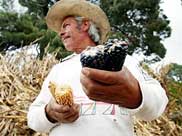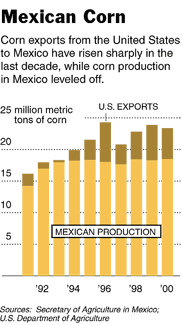February 27, 2002
In Corn's Cradle, U.S. Imports Bury Family Farms
By TIM WEINER
 |
| (Lynsey Addario/Saba, for The New York Times) |
| Lorenzo Rebollo, a farmer in Manzanillo, Mexico, says he cannot compete with the corn imported from the United States. "We work the land all our lives," he said. "But the farmers are growing more and getting less." |
 |
| (The New York Times) |
MANZANILLO, Mexico — For many generations, corn has been the sacred center of civilization in Mexico, the place where the grain was first cultivated some 5,000 years ago.
Gods and goddesses of corn filled the dreams and visions of the great civilizations that rose and fell here before the Spaniards came five centuries ago. Today the corn tortilla is consumed at almost every meal. Among the poor, sometimes it is the entire meal.
But the modern world is closing in on the little patch of maize, known as the milpa, that has sustained millions of Mexicans through the centuries. The powerful force of American agribusiness, unleashed in Mexico by the North American Free Trade Agreement, may doom the growing of corn as a way of life for family farmers here, agronomists and economists say.
Lorenzo Rebollo, a 53-year-old dirt farmer, works two and a half acres of corn and beans here on the slopes of the eastern state of Michoacán, in Mexico's central highlands, where corn was first grown as a food crop, archaeologists say. Mr. Rebollo is one of about 3 million Mexicans who farm corn and support roughly 15 million family members.
His grown sons have left for the United States to make a living, and Mr. Rebollo says he may be the last man to farm this patch of earth. It is the same story all over Mexico: thousands of farmers pulling up stakes every year, heading for Mexico City or the United States. Some grew coffee or cut sugar cane. But most grew corn.
Roughly a quarter of the corn in Mexico is now imported from the United States. Men like Mr. Rebollo cannot compete against the mechanized, subsidized giants of American agriculture.
"Corn growing has basically collapsed in Mexico," Carlos Heredia Zubieta, an economist and a member of Mexico's Congress, said in a recent speech to an American audience. "The flood of imports of basic grains has ravaged the countryside, so the corn growers are here instead of working in the fields."
The facts are stark. Since Nafta took effect eight years ago, imports of corn to Mexico from the United States have increased nearly eighteenfold, according to the United States Department of Agriculture. The imports will probably keep growing for the next six years as the final phases of Nafta take effect.
In the United States, corn growers receive billions of dollars a year in subsidies from Congress, much of it going to huge agribusiness operations. That policy fuels huge surpluses and pushes corn prices down.
Free trade and Mexico's own farm policies "threaten the ability of Mexican farmers to continue to grow corn," said Alejandro Nadal, a professor at the Colegio de México and the author of a study on the issue.
In Mexico, Nafta did away with many traditional subsidies and generous price supports. Some contend it is doing away with small farmers. About 90 percent of Mexico's corn farmers work fields of five acres or less, and their survival instincts are driving them farther and farther up Mexico's mountainsides as they strive to grow enough to get by.
"We work the land all our lives," Mr. Rebollo said. "But the farmers are growing more and getting less."
Under a slowly lifting ceiling, the United States will be able to export all the corn it wants to Mexico, duty free, by 2008. Nafta's drafters told Mexico's farmers that as the ceiling lifted, the price of corn in Mexico would slowly fall toward United States and international prices over the 15-year period.
But instead, prices plunged quickly, converging with the free-market price by 1997. This was good news for big companies in Mexico importing corn for animal feed and processed food. But it was hard on the farmers, who have little political clout under the government of President Vicente Fox, an ardent free-trader.
The effect of American imports on Mexican agriculture was not unforeseen. "Integration into the global economy will also accelerate the social dislocation that rapid modernization inevitably brings to a developing economy," Bernard Aronson, a former assistant secretary of state for Latin American affairs, wrote eight years ago as the trade pact took effect.
But some things were not predicted. One unforeseen result of the collapse of corn farming, Mr. Nadal warns, will be the loss of genetically unique kinds of corn. As imports grow and farmers give up their fields, he said, ancient varieties like the succulent blue corn used for tortillas may be endangered. Some may already be lost, he said.
"If traditional growers abandon corn production — as the Nafta strategy foresees — then even more significant genetic erosion will occur," he said.
The importation of bioengineered corn from the United States is a separate but heated issue. Mexico's government does not permit the planting of genetically modified corn. But the new modified breeds can be imported as food or feed. The science journal Nature and Mexico's government published findings last year showing that bioengineered genes from American imports have invaded ancient varieties of corn in the state of Oaxaca.
Nafta has had demonstrable benefits for many sectors of the Mexican economy that have become competitive, and Mr. Fox says it is no longer possible for the government to step in and assist farmers.
State legislators who want Mexico to protect its corn the way Japan protects its rice have had no luck swaying him. Mr. Fox's agriculture minister, Javier Usabiaga — a highly successful exporter known as the Garlic King in Guanajuato, his home state as well as Mr. Fox's — says that a farmer who cannot survive in the 21st century is simply "going to have to find another job."
Farmers like Mr. Rebollo are regarded as artifacts of an earlier, simpler age. "I have this little bit of land, and I work it, and it's good hard work," he said as he walked his fallow field. "But I think when I go it will go too."
Copyright 2002 The New York Times Company
![]()